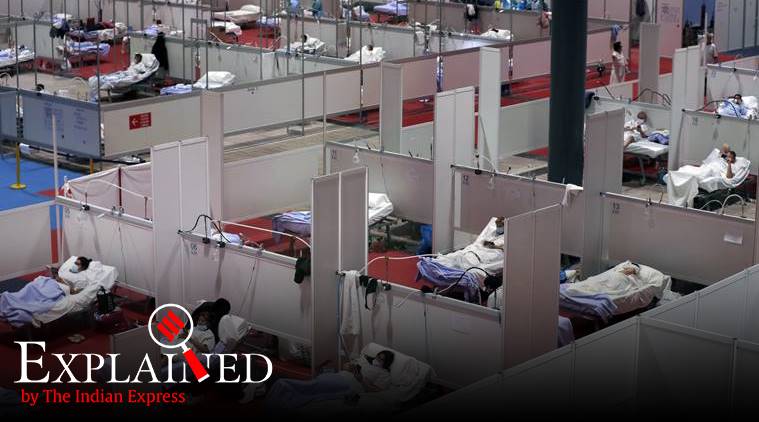- India
- International
Cytokine storms: When the body’s own immune system leads to COVID-19 deaths
What is the cytokine storm and how is it triggered when a virus (or antigen) enters the body for the first time? How does the body’s immune system work?
 A view of a temporary field hospital in Madrid, Spain. (AP Photo/Manu Fernandez)
A view of a temporary field hospital in Madrid, Spain. (AP Photo/Manu Fernandez)
Can the response of the body’s immune system explain why some people are succumbing to the novel coronavirus infection? Evidence is emerging that a subset of the infected patients develop severe COVID-19 because of an overreaction of their immune systems, which triggers what is known as a “cytokine storm syndrome” (CSS).
While various studies have shown that the disease has more severe consequences for those above the age of 60 years, and especially those with existing co-morbidities such as heart disease, diabetes, hypertension, chronic respiratory disease and cancer, some countries have also reported deaths of younger people, including teenagers, after catching the infection.
According to a WHO report from February 28, an analysis of over 55,000 laboratory-confirmed cases revealed that 2.5 per cent of those under the age of 19 developed severe disease from the coronavirus, and 0.2 per cent were critically ill.
Critical COVID-19 patients are defined by manifestations that include respiratory failure requiring mechanical ventilation and shock or organ failure that requires intensive care, and which may lead to death.
So what is the cytokine storm and how is it triggered when a virus (or antigen) enters the body for the first time? How does the body’s immune system work?

The immune systems in our bodies protect us from bacteria, viruses, and parasites by removing them from our systems. The immune system gets activated by things that the body does not recognise as its own. These things are called antigens, and include bacteria, fungi and viruses.
An effective immune system response involves inflammation, an important and indispensable part of the process. This is visible when, for example, you hurt your knee or ankle — the area of this external injury becomes red and swollen, and the immune system in response deploys white blood cells to the injured area to begin work on repairs. Without such an immune response, injuries would not heal, and infections would become deadly.
📢 Express Explained is now on Telegram. Click here to join our channel (@ieexplained) and stay updated with the latest
Inflammation has an important protective function. The release of inflammatory mediators increases the blood flow to the area, which allows larger numbers of immune system cells to be carried to the injured tissue, thereby aiding the repairing process.
However, if this inflammatory response is not regulated, very dangerous consequences can follow. This is when a ‘cytokine storm’ can be triggered. The damage to the surrounding cells can be catastrophic, leading to sepsis and potentially, death.
What then, is the role of cytokines in the immune system?
Cytokines are signalling proteins that are released by cells at local high concentrations — a cytokine storm or CSS is characterised by the overproduction of immune cells and the cytokines themselves because of a dysregulation in the process.
A severe immune reaction, leading to the secretion of too many cytokines in the bloodstream, can be harmful since an excess of immune cells can attack healthy tissue as well.
But what causes the severe immune reaction in the first place?
The United States National Cancer Institute (NCI) says on its website that a cytokine storm can occur due to an infection, auto-immune condition, or other diseases. Signs and symptoms include high fever, inflammation (redness and swelling), severe fatigue, and nausea.
Cytokine storms are not exclusive to coronavirus patients. It is an immune reaction that can occur during other infectious and non-infectious diseases as well.
How does CSS impact a COVID-19 patient?
In the case of any flu infection, a cytokine storm is associated with a surge of activated immune cells into the lungs, which, instead of fighting off the antigen, leads to lung inflammation and fluid build-up, and respiratory distress.
CSS is seen as a likely major cause of mortality in both the 1918-20 Spanish Flu that killed more than 50 million people worldwide, and the H1N1 (swine flu) and H5N1 (bird flu) outbreaks in recent years.
Increased pro-inflammatory cytokine responses against human coronaviruses such as SARS-CoV-1 (which caused SARS), SARS-CoV-2 (which is responsible for the current COVID-19 pandemic), and MERS can result in acute lung injury and acute respiratory distress syndrome (ARDS).
If the clinical features of CSS are not recognised and adequate treatment is not promptly instituted, multiple organ failure can result. Researchers writing in The Lancet have suggested that all severe COVID-19 patients should be screened for hyper inflammation.
Here’s a quick Coronavirus guide from Express Explained to keep you updated: What can cause a COVID-19 patient to relapse after recovery? | COVID-19 lockdown has cleaned up the air, but this may not be good news. Here’s why | Can alternative medicine work against the coronavirus? | A five-minute test for COVID-19 has been readied, India may get it too | How India is building up defence during lockdown | Why only a fraction of those with coronavirus suffer acutely | How do healthcare workers protect themselves from getting infected? | What does it take to set up isolation wards?
More Explained
EXPRESS OPINION
Apr 26: Latest News
- 01
- 02
- 03
- 04
- 05










































